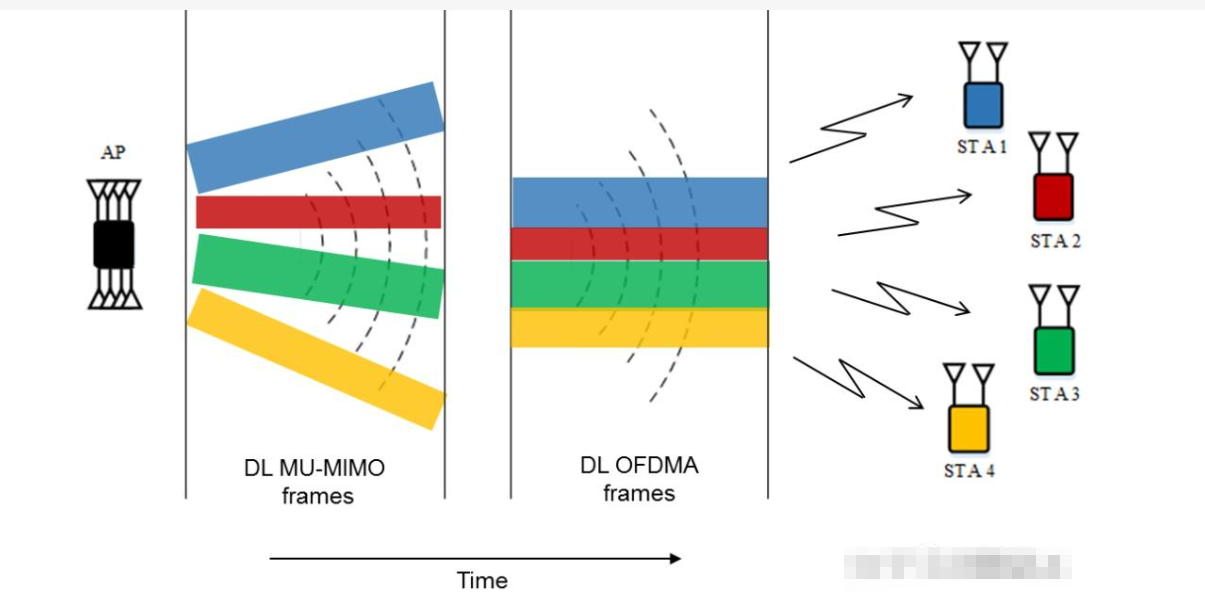802.11ac VS 802.11ax represents chips IPQ4019 and IPQ5018-support MU-MIMO-OFDMA-TWT technology

802.11ac VS 802.11ax represents chips IPQ4019 and IPQ5018-support MU-MIMO-OFDMA-TWT technology
WiFi 5 (also known as 802.11ac) and WiFi 6 (also known as 802.11ax) are two different versions of the wireless networking protocol that have some notable differences in terms of performance, speed, and features. Here are the main differences between them:

SPEED AND BANDWIDTH:
WiFi 5: The maximum speed can reach about 3.5 Gbps (gigabits per second).
WiFi 6: The highest speed can reach about 9.6 Gbps.
Multi-user capability:
WiFi 5: supports multi-user (MU-MIMO) technology, but is mainly limited to serving a small number of devices at the same time.
WiFi 6: introduces a more advanced multi-user technology called OFDMA (Orthogonal Frequency Division Multiplexing), which can more efficiently serve multiple devices simultaneously on the network and reduce congestion.
Network Capacity:
WiFi 5: Suitable for medium-density device connections, such as home networks or small offices.
WiFi 6: Designed for environments with high-density device connections, such as crowded public spaces, large corporate offices, and stadiums.
Low Latency:
WiFi 6: BSS Coloring technology is introduced, which can reduce the problem of hidden nodes in the network, thereby reducing network delay.
Security:
WiFi 6: The WPA3 security protocol has been introduced to provide stronger encryption and security, and it is more difficult to crack than WPA2.
Power Management:
WiFi 6: Support Target Wake Time (TWT) function, which can more effectively manage power consumption of devices and extend battery life, especially for IoT devices.
Channel Utilization Efficiency:
WiFi 6: The basic service set (BSS) color technology is introduced, which can reduce interference between different BSSs in the same frequency band and improve channel utilization efficiency.
Beamforming:
WiFi 6: Supports more advanced beamforming technology, which can direct signals more precisely, improving signal coverage and quality.What is the biggest difference between WiFi5 chip IPQ4019 and WiFi6 chip IPQ5018, why more people choose IPQ4019Both IPQ4019 and IPQ5018 are highly integrated wireless network chips, which are used in WiFi 5 and WiFi 6 networks respectively. Although they all work under different wireless network standards, the reason why people may be more inclined to choose IPQ4019 may be related to factors such as specific application scenarios, cost and availability.Here are some differences between IPQ4019 and IPQ5018:WiFi standard:IPQ4019: Support WiFi 5 (802.11ac) standard, suitable for earlier devices and networks.IPQ5018: Support WiFi 6 (802.11ax) standard, suitable for more advanced devices and networks, with higher performance and functions.Speed and features:IPQ4019: The upper speed limit is about 1.733 Gbps, which is suitable for medium-density networks.IPQ5018: Higher speed limit, up to 4.8 Gbps, suitable for high-density and high-performance networks.Multi-user capability:IPQ4019: Support MU-MIMO technology under WiFi 5.IPQ5018: Supports more advanced OFDMA and MU-MIMO technologies under WiFi 6, which can handle multi-user situations more effectively.Network capacity:IPQ4019: Suitable for medium-density networks, such as home networks.IPQ5018: Suitable for high-density networks, such as public places or large enterprise networks.Why more people may choose IPQ4019 may be due to the following reasons:Cost factor: IPQ4019 is a WiFi 5 standard chip, relatively speaking, it may be cheaper, and it is suitable for some projects with limited budget.Device and infrastructure support: By the time IPQ4019 hits the market, WiFi 6 may not have been widely adopted, so more people may consider using WiFi 5 devices.Application scenario: If the application scenario does not require particularly high network speed, or the device density is relatively low, IPQ4019 may already be able to meet the demand.It should be noted that as time goes by, the penetration rate of WiFi 6 technology and devices will gradually increase, and more people may turn to IPQ5018 or similar WiFi 6 chips for better performance and more advanced functions. Which chip to choose depends on specific project needs, budget, and technical requirements.











评论